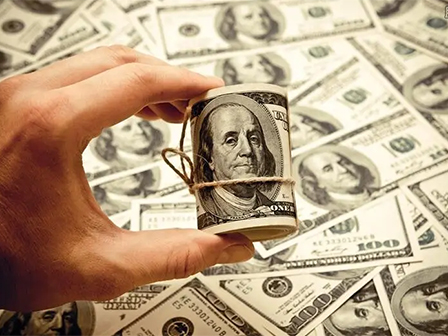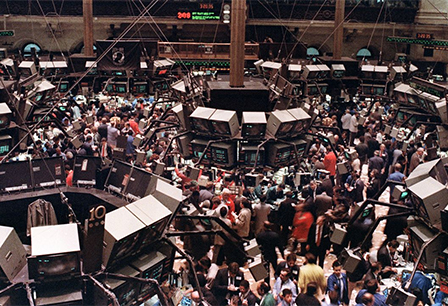Federal Reserve Chairman Jerome Powell threw markets into a tizzy on Tuesday as he spoke about the economy alongside his former boss, Carlyle Group co-founder David Rubenstein, at the Economic Club of Washington.
Stocks struggled for direction as investors tried to get a read on Powell’s economic outlook, attitude towards inflation and on future interest rate hikes. Wall Street cheered as the Fed chair said the disinflationary process has begun, then soured when he said the road to reaching 2% inflation will be “bumpy” and “long” with more rate hikes ahead.
Markets soared to new highs, before quickly falling to session lows and then recovering to close the day in the green.
“Powell doesn’t want to play games with financial markets,” said EY Parthenon chief economist Gregory Daco after the conversation. But at the same time, he said Powell wanted to communicate that the Fed’s “base case was not for inflation to come down as quickly and painlessly as some market participants appear to expect.”
Here’s why Powell thinks bringing down prices will be more difficult than investors anticipate.
Structural changes in the labor market: The US economy added an astonishing 517,000 jobs in January, blowing economists’ expectations out of the water. The unemployment rate fell to 3.4% from 3.5%, hitting a level not seen since May 1969.
The current labor market imbalance is a reflection of the pandemic’s lasting effect on the US economy and on labor supply, said Powell on Tuesday in answer to a question about the report. “The labor market is extraordinarily strong,” he said. Demand exceeds supply by 5 million people, and the labor force participation rate has declined. “It feels almost more structural than cyclical.”
“If we continue to get, for example, strong labor market reports or higher inflation reports, it may well be the case that we have to do more and raise rates more,” he said.
Core services inflation: Powell noted that he’s seeing disinflation in the goods sector and expects to soon see declining inflation in housing. But prices remain stubborn for services. Service-sector inflation, which is more sensitive to a strong labor market, is up 7.5% from the year prior through the end of 2022, and has not abated, he said.
“That sector is not showing any disinflation yet,” Powell said. “There has been an expectation that [higher prices] will go away quickly and painlessly and I don’t think that’s at all guaranteed.”
Geopolitical uncertainties: Powell also cited concerns that the reopening of China’s economy after the sudden end of Covid-Zero restrictions, plus uncertainty about Russia’s war on Ukraine could also affect the inflation path in ways that remain unclear.
Tech layoffs, Big Oil and soft landings: What investors are watching
▸ The labor market is strong, but tech layoffs keep coming. There were around 50,000 tech jobs cut in January, and the trend has continued into February.
Video conferencing service Zoom is one of the latest to announce layoffs. The company said Tuesday that it’s cutting 1,300 jobs or 15% of its workforce.
Zoom CEO Eric Yuan said in a blog post on Tuesday that Zoom ramped up employment quickly due to increased demand during the pandemic. The company grew three times in size within 24 months, he said and now it must adapt to changing demand for its services.
“The uncertainty of the global economy, and its effect on our customers, means we need to take a hard — yet important — look inward to reset ourselves so we can weather the economic environment, deliver for our customers and achieve Zoom’s long-term vision,” he wrote.
Yuan added that he plans to lower his own salary by 98% and forgo his 2023 bonus. Shares of Zoom closed nearly 10% higher on Tuesday.
The announcement comes just one day after Dell said it would lay off more than 6,500 employees.
Amazon (AMZN), Microsoft (MSFT), Google and other tech giants have also recently announced plans to cut thousands of workers as the companies adapt to shifting pandemic demand and fears of a looming recession.
▸ Neel Kashkari, president of the Federal Reserve Bank of Minneapolis told CNN that he is starting to think that the US economy could avoid a recession and achieve a so-called soft landing.
It’s hard to have a recession when the job market is still so robust, he told CNN’s Poppy Harlow on Tuesday on CNN This Morning.
Still, “we have more work to do,” Kashkari told Harlow, adding that the labor market is “too hot” and that is a key reason why it is “harder to bring inflation back down.”
Although many investors are starting to think the Fed may pause after just two more similarly small hikes, to a level of around 5%, Kashkari said he believes the Fed may have to raise rates further. Kashkari has a vote this year on the Federal Open Market Committee, the Fed’s interest-rate setting group.
▸ It’s a good time to be in the oil business. BP’s annual profit more than doubled last year to an all-time high of nearly $28 billion.
The British energy company said in a statement that underlying replacement cost profit rose to $27.7 billion in 2022 from $12.8 billion the previous year. The metric is a key indicator of oil companies’ profitability.
BP (BP) also unveiled a further $2.75 billion in share buybacks and hiked its dividend for the fourth quarter by around 10% to 6.61 cents per share.
BP’s shares rose 6% in Tuesday trading following the news. Over the past 12 months, its shares have soared 24%.
The earnings are the latest in a string of record-setting results by the world’s biggest energy companies, which have enjoyed bumper profits off the back of skyrocketing oil and gas prices.
Last week, another energy major Shell reported a record profit of almost $40 billion for 2022, more than double what it raked in the previous year after oil and gas prices jumped following Russia’s invasion of Ukraine.
On Wednesday it was TotalEnergie (TTFNF)s turn. The French company posted annual profit of $36.2 billion for 2022, double the previous year’s earnings.
Disney has big problems
Disney has found itself in the middle of a culture war battle that could end up transferring Disney World’s governance to a board appointed by Florida Gov. Ron DeSantis. And that may be the least of Disney’s problems, writes my colleague Chris Isidore.
The company faces a media industry in turmoil, plunging cable subscriptions, a still-recovering box office, massive streaming losses, activist shareholders, possible reorganization and layoffs and growing labor disputes with employees. That’s a lot for CEO Bob Iger to handle.
Iger, who retired as CEO in 2020 only to be brought back in November, has been mostly quiet about his plans for the company since his return. That ends at 4:30 p.m. ET Wednesday when he is set to begin an earnings call with Wall Street investors.
Click here to read more about what to look for on what is certain to be a closely-followed call.












